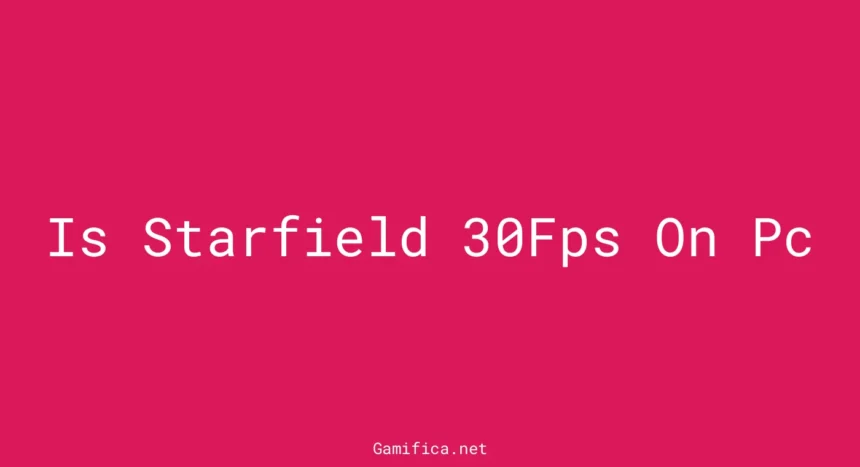Are you ready to blast off into the depths of space with Starfield? As PC gamers, we all know the importance of smooth gameplay and impressive frame rates. But the burning question on everyone’s mind is, “Is Starfield locked at 30fps on PC?” Don’t worry, fellow space explorers, we’re here to shed some light on this celestial mystery. In this article, we’ll delve into the fascinating world of frame rates, explore the variance you can expect on PC, and even take a look at the buttery-smooth 30fps experience on Xbox Series X/S. So fasten your seatbelts and prepare for an interstellar journey through the realm of Starfield optimization. By the time we’re done, you’ll have all the answers you need to boldly go where no gamer has gone before.
Understanding Frame Rates in Starfield on PC
Frame rate, the heartbeat of any PC game, becomes the center of attention for Bethesda’s ‘Starfield,’ where every second of gameplay is a dance of pixels and performance. On PC, gamers expect a symphony of swift and seamless visuals, but the reality of frame rate in ‘Starfield’ is a dynamic narrative, one that unfolds according to the rhythm of individual PC specifications.
Frame Rate Variance on PC
In the world of ‘Starfield,’ PC gamers navigate through a universe where frame rate isn’t a fixed constellation but a variable star, shining at different intensities based on the power of their gaming rigs. Unlike its Xbox Series X/S counterpart, which cruises at a steady 30fps, the PC version of ‘Starfield’ can soar to the higher echelons of performance, hitting an average of 60fps—a number that’s as fluid as the space explorations within the game.
Traversing the cosmic cities of ‘Starfield’ can be a demanding task for any system, with intricate details and expansive environments that can cause frame rates to dip. This digital odyssey on PC is a testament to the hardware’s prowess, where the difference between a stutter or smoothness can hinge on the might of a graphics card or the swiftness of a processor.
Maximizing Frame Rate with Dynamic Resolution and FSR 2
Adventurers seeking to optimize their interstellar journey can employ techniques such as dynamic resolution and FSR 2 (FidelityFX Super Resolution). These technologies combine to form a bulwark against performance drops, ensuring that gamers can experience ‘Starfield’ at up to 60fps. This collaboration of settings is akin to navigating an asteroid field with precision—each adjustment fine-tuning the gameplay to deliver a smoother, more responsive experience that is critical during the game’s most intense moments.
| Aspect | Detail |
|---|---|
| Xbox Series X/S Frame Rate | Locked at 30fps |
| PC Frame Rate | Averages around 60fps, varies by hardware |
| Frame Rate Influencing Factors | PC specs, city density, in-game action |
| Frame Rate Optimization | Dynamic resolution, FSR 2 |
For those who have charted their course across the universe of ‘Starfield’ on PC, the frame rate is not a mere number but a measure of immersion. It’s the difference between a choppy dogfight among the stars and a fluid ballet of spaceships. As players delve deeper into the cosmos, they remain ever mindful of the frame rate frontier—a boundary only their PC hardware can push.
However, it’s important to note that while technology can bridge gaps in performance, the true potential of ‘Starfield’ on PC lies within the core of each gaming system, waiting to be unlocked by those who dare to explore the infinite.
30fps on Xbox Series X/S
In the universe of Starfield, Xbox Series X/S users will navigate the cosmos at a steady 30 frames per second (fps). This deliberate cap is a balancing act to preserve the game’s rich tapestry of visuals without compromising on the immersive detail that has come to define a Bethesda experience. Though the PC version boasts the flexibility to reach 60fps, the decision to limit the Xbox Series X/S to 30fps was taken with the intent of delivering consistently high-quality graphics and resolution across the board. It’s a trade-off that ensures the vast expanses of Starfield remain as visually arresting as possible.
While the topic of frame rates often sparks debate among gaming enthusiasts, with some advocating for higher fps for smoother gameplay, it’s crucial to recognize that preferences are subjective. A contingent of players may indeed find that 30fps offers a perfectly satisfactory gaming experience, especially when it is accompanied by other graphical enhancements. Others, however, may argue that the fluidity offered by 60fps creates a more responsive and engaging environment, particularly in fast-paced scenarios or during space combat sequences.
Displaying the FPS Counter on PC
For those charting the performance frontier on PC, Starfield provides the tools to monitor frame rates with ease. By pressing the Windows Key + G, players can summon the Xbox Game Bar and locate the FPS counter feature nestled in the bottom left corner of the overlay. This real-time tracking tool empowers gamers to keep a vigilant eye on their performance metrics, enabling them to fine-tune their settings for the smoothest interstellar journey possible. Whether you’re cruising through asteroid fields or docking at a bustling spaceport, the FPS counter is an invaluable companion for maintaining an optimal gaming experience.
Indeed, as players progress through Starfield‘s myriad of planets and engage in complex interactions, the ability to track and adjust performance on the fly becomes not just a convenience, but a necessity for those seeking to extract the utmost potential from their hardware.
Starfield Optimization Issues on PC
Despite its potential for high-performance gameplay, Starfield has encountered turbulence when it comes to optimization on PC, particularly for those with Nvidia graphics cards. In a surprising twist, the much-anticipated game-ready drivers from Nvidia, typically a beacon of performance enhancement, did not significantly boost Starfield‘s performance. The absence of tailored optimization has left some players facing a nebula of stability issues, including unexpected frame rate drops and less-than-ideal gameplay experiences.
The quest for seamless interstellar exploration has thus been met with obstacles, as poor optimization can pull players out of the immersive experience and into the realm of technical troubleshooting. It’s a reminder that even in the vast, procedurally generated universe of Starfield, the devil is in the digital details, and achieving the perfect balance of performance and visual splendor is an ongoing mission.
Conclusion
As we venture into the final analysis of Starfield‘s performance metrics, it is crucial to recognize the intricate dance between hardware capabilities and software optimization. On the PC platform, Starfield has shown its potential to reach an impressive 60fps, offering silky-smooth gameplay that can elevate the gaming experience to new heights. However, this level of performance is not a given; it hinges on a constellation of variables, including the might of the player’s PC specs, the utilization of dynamic resolution, and the innovative employment of FSR 2.
For those gaming on the Xbox Series X/S, the developers have chosen a different path, one that prioritizes visual fidelity and resolution by capping the frame rate at a steady 30fps. This design decision ensures that every player can immerse themselves in the vast universe of Starfield with consistent graphical quality, allowing for a seamless exploration of its expansive worlds.
It’s worth noting that optimization challenges on the PC, particularly for those with Nvidia graphics cards, have stirred up some cosmic turbulence, leading to varying degrees of stability and gameplay quality. Addressing these issues is a continuous quest for equilibrium between performance and visual splendor—a pursuit that the game’s developers are undoubtedly navigating with great care.
To gain a deeper understanding of Starfield‘s performance across different platforms, interested gamers and tech enthusiasts can delve into the comprehensive benchmarks provided by The Verge. Additionally, for a thorough explanation of the game’s 30fps limitation on Xbox consoles, the insights from Radio Times shed valuable light on the subject.
As this stellar odyssey of frame rates and resolutions unfolds, one thing remains clear: the developers of Starfield are committed to delivering a visually stunning and enthralling gaming experience, whether you’re charting new galaxies on your PC or console. Stay tuned and ready to adjust your settings to embark on an interstellar journey tailored to your personal gaming rig and preferences.
FAQ
Q: Is Starfield 30fps on PC?
A: The Starfield frame rate on Xbox is locked to 30fps, but on PC, the fps can vary depending on your computer’s specifications.
Q: What is the average fps in Starfield on PC?
A: In our experience, Starfield on PC hovers at around 60fps on average, but this can vary depending on your computer’s specs.
Q: Can the fps drop while navigating Starfield cities on PC?
A: Yes, there is a potential for framerate drops while navigating Starfield cities on PC.
Q: Is the maximum fps in Starfield on PC capped?
A: The maximum fps in Starfield on PC is not capped, as it depends on your computer’s specifications and performance.







